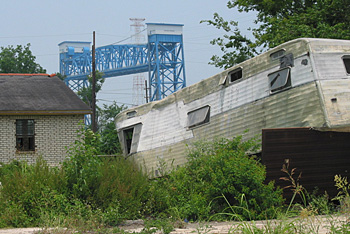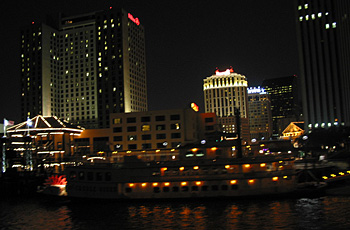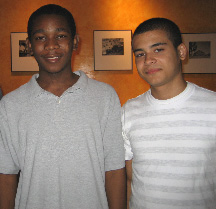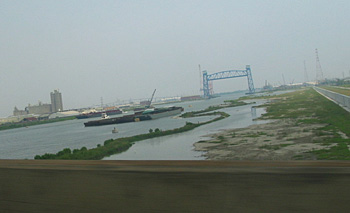After spending a week in New Orleans in June, I am even more convinced that our mission there was a good and important one: to do everything we can to help the city rebound. Just before I left, one friend grumbled about the potential futility of devoting resources to a place that continues to be so vulnerable to the machinations of Mother Nature. She has a point, but among the many lessons I learned during our week, one resonates the most: As hard hit as New Orleans has been, it remains, in so many ways, the wonderful city it has always been.
It is still a city whose people make open-mindedness and self-expression major priorities. It is a city where music is omnipresent. Where diversity isn’t a strategy but a fact of life. And many of New Orleans’s neighborhoods are nearly all the way back. Walk down Frenchman Street and you’ll find world-class musicians performing for free at a half-dozen venues. Go to Magazine Street for the funky shops and galleries. Eat at Jacques-Imo’s and then hear a group like the Rebirth Brass Band next door at the Maple Leaf. Everyone reports that Jazz Fest is better than ever. And there’s always the French Quarter if you like that sort of thing. The point is, lots of the people and places that have always made New Orleans one of the most popular cities on earth are still there. And now is as good a time as any to visit.
That said, New Orleans is also a place whose age-old problems—some experts mention classism, racism, poor education, violent crime, political corruption, and, obviously, coping with hurricanes—appear to have been exacerbated by the ravages of Hurricanes Katrina and Rita. And when you hear estimates that the storms destroyed about 200,000 homes and eliminated 190,000 jobs, the numbers stun you, but you don’t really get it until you see first-hand how devastated some of the neighborhoods still are. I know when I saw the Lower Ninth Ward, my mind was boggled by all that needs to be done for New Orleans. Without those neighborhoods, the city is less likely to be a place where great musicians seem to grow right out of the soil.
Helping build the Musicians’ Village is a great start. To know that we eight Berklee staffers leveled floors, nailed siding, laid roof shingles, installed ventilated soffit, painted walls, and more, is a good feeling. In the grand scheme of things, our contribution was a small one, but without a series of small contributions, there can be no large turnaround. The big question that we all seemed to be asking ourselves afterward was, “What should we do next?”

There’s still plenty of work to do in the Ninth Ward.
Beyond the possibility of another Berklee-sponsored Habitat crew making a future trip, there are many other ways the college can help. We can continue to foster strong relationships with our Crescent City alumni and help them stay connected with each other. Our mid-week alumni event was well-attended, and I was amazed to find that most attendees had never met any of their fellow New Orleans alumni. Also attending the event were two young New Orleans musicians—Joe Dyson and Max Moran—who will enter Berklee on full-tuition scholarships this fall. If the college continues to bring talented players from New Orleans to Boston, then we will be doing our bit to help make sure a great music education is available to the city’s deserving musicians.
From left, Joe Dyson and Max Moran, at the New Orleans alumni event
There are many other ways people at Berklee and elsewhere can help. It is possible to have a large impact by doing the sorts of work we’re already good at. I learned how to use a few power tools while I was in New Orleans, but I’m still better with pen and paper than hammer and nail. If, for example, communicators can occasionally volunteer to raise awareness about the needs of the city, then perhaps New Orleans will be a more prominent story in the national media.
As groups like ours and others go to New Orleans and work to rebuild it, of course we’re going to find ourselves musing about what kind of new New Orleans we are creating. Many people in New Orleans welcome the idea of Donald Trump’s proposed 70-story tower in the Central Business District because it will help bring money and jobs to the city. Others ask whether or not such developments permanently change the character of the city and make it less like the old New Orleans. Whatever happens, change is inevitable if New Orleans is going to bounce back. As long as that change includes an infallible levee system and a well-funded plan for restoring the wetlands, I’m all for it.
New levee is far right. Will it hold next time?
So no matter what you do, there’s probably some way you can have a positive impact on helping New Orleans recover. Even merely going there and being a tourist for a few days is contributing to the relief effort. As for Berklee, being a college that emphasizes the importance of community service, what better melding of our mission and values could there be than contributing to N.O.? Our college is “founded on jazz and popular music rooted in the African cultural diaspora,” and there is no city more intrinsically tied to those words, historically, than New Orleans. We are the world’s leading college of contemporary music, and New Orleans is the city where, we can argue, contemporary music was born.
I am blown away by the extraordinary efforts of my Berklee colleagues. Everyone displayed ceaseless dedication, high energy, and teamwork all the way through. I enjoyed every moment of working and eating (those were the two main activities, after all) with this crew. In particular, I’d like to acknowledge the leadership and inspiration provided at every moment by Roya Nassery. Not only did she come up with the idea for this trip, she coordinated every detail and held us all together at every moment. I am proud to work with her and with everyone else in our group. And I am grateful to all the Berklee departments that supported this trip.
There’s a Neville Brothers song on Yellow Moon called “My Blood” (hence the title of this post) that perfectly sums up my feelings about New Orleans. The lyrics draw a connection between all people, those suffering and those not. No matter who we are and where we are, we always have a responsibility to help each other. We all get so caught up in the day-to-day rhythms of our own lives that we easily forget this. I know I do. I also know that the best way for me to keep the needs of New Orleans in my head and heart is to get back there as soon as possible. I don’t know when that will be, but I hope I see you there.
– Rob Hochschild (August 2007)
(Thanks for the video, Jason!)



Thank you so much for your dedication in helping my hometown. In this time of self centeredness and greed, it is wonderful to know that true Americans are still out there caring for the fate of their fellow citizens. I have the Yellow Moon album (I am showing my age.) and agree with you and its message. For all of her problems, New Orleans has much to teach America if only America would listen. Again, thank you for your help. Maybe one day I will be able to meet you at the Musician’s Village. We can rebuild this country together.
Jolie
By: doctorj on August 5, 2007
at 12:31 pm
Thanks on behalf of all of us in NOLA helping to rebuild our city. I’m on the N.O. Habitat Board of Directors, and I especially want to thank you for your dedication to the work that we are doing here!
– Andy Lee
By: alee70124 on August 18, 2007
at 12:25 pm